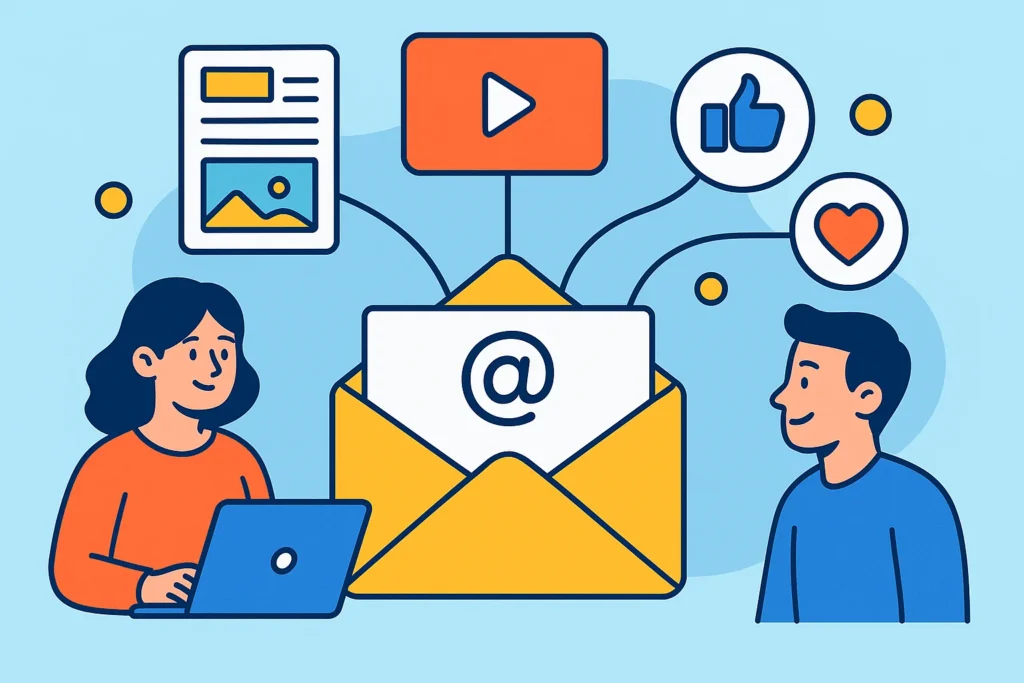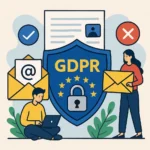Now Reading: Proven Content Types: 13 Most Effective Formats for Content Marketing Success
-
01
Proven Content Types: 13 Most Effective Formats for Content Marketing Success
Proven Content Types: 13 Most Effective Formats for Content Marketing Success

In today’s digital landscape, creating the right content can make or break your marketing strategy. Understanding the most effective types of content for content marketing isn’t just helpful—it’s essential for businesses looking to cut through the noise and connect with their target audience.
In this comprehensive guide, we’ll explore the most effective types of content for content marketing, backed by current data and expert insights, to help you craft a winning strategy that resonates with your audience and achieves your business objectives.
Key Takeaways
- Blog posts remain among the most effective content types, with both short-form and long-form articles driving significant traffic and engagement
- Video content continues to dominate engagement metrics across platforms, particularly how-to guides and product demonstrations
- Case studies and testimonials provide powerful social proof that builds trust and influences purchasing decisions
- Infographics simplify complex information and are highly shareable, making them excellent for building backlinks
- Interactive content like quizzes and calculators keeps visitors on your site longer and increases engagement
- Email newsletters maintain consistent audience connections and drive conversions through personalized content
- Podcasts reach on-the-go audiences and help humanize your brand through authentic conversations
Blog Posts: The Foundation Of Content Marketing
Blog posts continue to be the cornerstone of effective content marketing strategies. According to Semrush’s State of Content Marketing report, 55% of content marketers report that both short-form and long-form blog posts are among their top-performing content types. This enduring popularity isn’t surprising, as blogs offer exceptional versatility and SEO benefits.
Long-Form Articles (1,000+ Words)
Long-form content, generally considered to be articles exceeding 1,000 words, provides several distinct advantages:
- Comprehensive coverage of topics that establishes your authority in your industry
- Higher search engine rankings as Google’s algorithms prioritize in-depth, detailed discussions
- Increased dwell time on your website, a key metric that signals content quality to search engines
- More opportunities to naturally incorporate relevant keywords without stuffing
- Greater potential for attracting quality backlinks from other websites
When creating long-form content, focus on providing genuine value rather than simply hitting a word count. Research thoroughly, incorporate relevant statistics, and break up text with subheadings, bullet points, and visuals to improve readability.
Short-Form Blog Posts
Despite the SEO advantages of long-form content, short-form blog posts (typically under 1,000 words) remain highly effective for certain purposes:
- Quick consumption by readers with limited time or shorter attention spans
- Concise delivery of timely information or simple concepts
- Higher completion rates as readers are more likely to finish shorter pieces
- Faster production allowing for more frequent publishing schedules
- Better mobile experience for on-the-go readers
Short-form content works particularly well for news updates, quick tips, or introductory pieces that can later link to more comprehensive resources on your site.
How-To Content
“How-to” content deserves special mention as one of the most effective blog formats. These instructional pieces directly address common questions and challenges your audience faces. By providing clear, actionable solutions, you position your brand as helpful and knowledgeable.
How-to content also aligns perfectly with search intent, as people often turn to Google when looking for instructions on completing specific tasks. Creating comprehensive guides that walk readers through processes step-by-step can significantly boost your organic traffic.
Video Content: Engaging Visual Storytelling
Video content has emerged as one of the most effective types of content for content marketing, with engagement rates that often surpass text-based formats. The visual and auditory nature of video makes complex information more accessible and engaging for audiences across demographics.
Types Of Effective Video Content
Several video formats have proven particularly effective for content marketing:
- How-to tutorials and demonstrations that show your product or service in action
- Brand storytelling videos that communicate your company’s mission and values
- Customer testimonials that provide authentic social proof
- Behind-the-scenes content that humanizes your brand
- Webinars and educational presentations that establish thought leadership
- Product reviews and comparisons that help customers make informed decisions
Video Content Best Practices
To maximize the effectiveness of your video content:
- Keep it concise – While optimal length varies by platform, shorter videos generally perform better
- Add captions – Many viewers watch with the sound off, especially on social media
- Optimize for search – Use relevant keywords in titles, descriptions, and tags
- Include clear CTAs – Guide viewers on what to do next after watching
- Ensure mobile compatibility – Most video consumption happens on mobile devices
- Repurpose content – Extract clips for social media, transcribe for blog posts, etc.
Useful Articles:
Case Studies And Testimonials: Proof That Builds Trust
Case studies and testimonials represent some of the most effective types of content for content marketing because they leverage the power of social proof. These formats demonstrate real-world applications and results, helping potential customers envision how your product or service could benefit them specifically.
Effective Case Study Structure
A compelling case study typically follows this structure:
- Challenge – Describe the problem or pain point the customer was experiencing
- Solution – Explain how your product or service addressed this challenge
- Implementation – Detail the process of putting your solution into action
- Results – Highlight specific, measurable outcomes with data when possible
- Customer quote – Include direct testimonials for authenticity
Case studies work particularly well for B2B companies with complex products or services that require significant investment. They help simplify the decision-making process by showing tangible results and return on investment.
Leveraging Customer Testimonials
Customer testimonials can be incorporated throughout your marketing materials in various formats:
- Written quotes on your website, particularly on product pages and landing pages
- Video testimonials that capture authentic customer enthusiasm
- Social media highlights showcasing positive customer feedback
- Review compilations that demonstrate widespread satisfaction
The most effective testimonials include specific details about how your product or service solved a particular problem, rather than generic praise. Whenever possible, include the customer’s full name, company (for B2B), and photograph to enhance credibility.
Infographics: Visual Data Storytelling
Infographics remain one of the most effective types of content for content marketing due to their ability to present complex information in an easily digestible visual format. These graphic visual representations combine data, design, and narrative to explain concepts that might otherwise require lengthy text.
Benefits Of Infographics
Infographics offer several distinct advantages:
- Improved information retention – People remember visual information better than text alone
- Increased shareability – Infographics are among the most shared content types on social media
- Enhanced link building – Other websites often embed infographics with attribution links
- Simplified complexity – Technical or data-heavy topics become more accessible
- Brand awareness – Consistent design elements reinforce your visual identity
Creating Effective Infographics
To maximize the impact of your infographics:
- Start with compelling data – Base your infographic on interesting statistics or research
- Tell a coherent story – Organize information in a logical flow with a clear narrative
- Keep design clean – Avoid cluttering the visual with too much information
- Maintain brand consistency – Use your brand colors, fonts, and style guidelines
- Make it mobile-friendly – Ensure the infographic displays properly on smaller screens
- Include sources – Cite all data sources to build credibility
- Add your logo – Ensure proper attribution when the infographic is shared
Ebooks And White Papers: In-Depth Value
Ebooks and white papers represent some of the most effective types of content for content marketing when targeting audiences seeking comprehensive information. These longer-form assets provide in-depth coverage of industry topics and demonstrate your organization’s expertise and thought leadership.
Ebooks: Comprehensive Guides
Ebooks typically offer practical, actionable information in an accessible format:
- Length – Usually range from 2,000 to 20,000 words
- Style – More conversational and visually engaging than white papers
- Purpose – Often used as lead magnets to capture email addresses
- Topics – Comprehensive guides, step-by-step instructions, or collections of related content
- Format – Typically designed as PDF downloads with visual elements
Effective ebooks provide genuine value rather than simply promoting your products. They should address specific pain points or questions your audience has, positioning your brand as a helpful resource rather than just a solution provider.
White Papers: Research-Based Authority
White papers take a more formal, research-oriented approach:
- Length – Typically 3,000 to 5,000 words
- Style – More academic and data-driven than ebooks
- Purpose – Establish thought leadership and influence decision-makers
- Topics – Industry trends, research findings, or technical explanations
- Format – Text-heavy with supporting graphics and citations
White papers are particularly effective in B2B marketing, where 79% of buyers report sharing them with colleagues during the decision-making process. They work best when addressing complex topics that require detailed explanation or when presenting original research that provides new insights into industry challenges.
Useful Articles:
Podcasts: Audio Content For On-The-Go Audiences
Podcasts have emerged as one of the most effective types of content for content marketing, particularly for reaching audiences who prefer audio content or consume information while multitasking. This format allows brands to connect with listeners in a more intimate way, often during commutes, workouts, or other activities when visual content isn’t practical.
Podcast Marketing Benefits
Podcasts offer unique advantages compared to other content formats:
- Convenience for audiences who can listen while doing other activities
- Longer engagement time with episodes typically ranging from 20-60 minutes
- Personal connection through hosts’ voices and conversational style
- Authority building through in-depth discussions with industry experts
- Content repurposing opportunities into blog posts, social clips, and more
- Growing audience with podcast listenership continuing to increase year over year
Podcast Content Strategies
Effective podcast content strategies include:
- Interview series featuring industry experts, customers, or team members
- Educational episodes that dive deep into relevant topics
- Behind-the-scenes looks at your company culture and processes
- Case study discussions exploring real-world applications
- Q&A episodes answering common questions from your audience
- Industry news analysis providing expert commentary on recent developments
When developing a podcast, consistency is key. Establish a regular publishing schedule and maintain consistent audio quality to build listener loyalty over time.
Social Media Content: Platform-Specific Engagement
Social media content remains among the most effective types of content for content marketing due to its direct engagement capabilities and vast reach. However, success on social platforms requires understanding the unique characteristics and audience expectations of each channel.
Platform-Specific Content Strategies
Each social media platform favors different content formats and approaches:
- Professional insights and industry news
- Thought leadership articles
- Company updates and achievements
- Career development content
- B2B focused case studies
- High-quality visuals and short videos
- Behind-the-scenes content
- User-generated content featuring your products
- Stories for time-sensitive or casual content
- Reels for trending and entertaining short-form videos
- Timely updates and news
- Conversation starters and questions
- Customer service interactions
- Brief insights with relevant hashtags
- Polls and surveys
- Community-building content
- Longer video content
- Event promotions
- Group discussions
- Live streams and Q&A sessions
TikTok
- Entertaining, authentic short videos
- Trending challenges and sounds
- Educational content with a creative twist
- Behind-the-scenes glimpses
- User-generated content and collaborations
Social Media Content Best Practices
Regardless of platform, certain best practices apply across social media content:
- Consistency in posting schedule and brand voice
- Visual coherence that reinforces brand identity
- Audience engagement through questions, polls, and responses
- Strategic hashtag usage to increase discoverability
- Clear calls-to-action that guide next steps
- Analytics monitoring to refine your approach based on performance
Email Newsletters: Direct Audience Connection
Email newsletters stand out as one of the most effective types of content for content marketing due to their direct line to an opted-in audience. Unlike social media or search, email isn’t subject to algorithm changes, giving you more control over who sees your content and when.
Newsletter Content Strategies
Effective email newsletters typically incorporate several content elements:
- Curated content – Highlighting your best recent blog posts, videos, or podcasts
- Exclusive insights – Providing information not available on your public channels
- Industry news – Summarizing relevant developments with your expert perspective
- Product updates – Announcing new features or offerings to your most engaged audience
- Special offers – Providing subscriber-only discounts or early access
- Community highlights – Featuring user-generated content or customer success stories
Email Newsletter Best Practices
To maximize the effectiveness of your email newsletters:
- Segment your audience to deliver more relevant content to different subscriber groups
- Personalize content based on subscriber behavior and preferences
- Optimize subject lines to improve open rates
- Design for mobile since most emails are now read on mobile devices
- Include clear CTAs that guide readers toward specific actions
- Maintain a consistent schedule that sets appropriate expectations
- Test different formats to identify what resonates best with your audience
Email newsletters work particularly well as part of an integrated content strategy, driving traffic to your website and promoting other content formats while maintaining regular contact with your audience.
Useful Articles:
Interactive Content: Engaging Experiences
Interactive content has emerged as one of the most effective types of content for content marketing due to its ability to actively engage users rather than passively presenting information. This format transforms the audience from passive consumers to active participants, significantly increasing engagement metrics and information retention.
Types Of Interactive Content
Several interactive formats have proven particularly effective:
- Quizzes and assessments that provide personalized results
- Calculators and tools that solve specific problems
- Interactive infographics that allow users to explore data points
- Polls and surveys that gather opinions and provide instant feedback
- Interactive videos with clickable elements and decision points
- Configurators and product selectors that help users find the right solution
Benefits Of Interactive Content
Interactive content offers several advantages over static formats:
- Increased engagement time as users actively participate
- Higher conversion rates through personalized experiences
- Valuable data collection about user preferences and behaviors
- Enhanced learning through active participation
- Greater memorability of your brand and message
- Improved lead qualification through self-assessment
When creating interactive content, focus on providing genuine value rather than just novelty. The best interactive experiences solve real problems or answer important questions for your audience while gathering useful insights for your marketing strategy.
User-Generated Content: Authentic Advocacy
User-generated content (UGC) has become one of the most effective types of content for content marketing due to its authenticity and trust-building capabilities. This content, created by your customers rather than your marketing team, carries significant credibility with prospective buyers.
Types Of User-Generated Content
UGC can take many forms:
- Customer reviews and ratings on your website or third-party platforms
- Social media posts featuring your products or services
- Unboxing videos and product demonstrations
- Before-and-after photos showing results
- Customer stories and testimonials shared on their own channels
- Community discussions about your brand or offerings
Leveraging User-Generated Content
To effectively incorporate UGC into your content marketing strategy:
- Create branded hashtags to encourage and track customer content
- Run contests or challenges that motivate customers to create and share
- Feature UGC prominently on your website and social channels
- Request permission before repurposing customer content
- Acknowledge contributors by tagging or mentioning them
- Provide guidelines to help customers create more effective content
UGC works particularly well for consumer brands with visual products, but B2B companies can also leverage customer success stories, implementation examples, and professional testimonials to create authentic advocacy content.
Landing Pages: Conversion-Focused Content
Landing pages represent one of the most effective types of content for content marketing when it comes to converting visitors into leads or customers. Unlike general website pages, landing pages are specifically designed with a single objective in mind, whether that’s capturing email addresses, generating sales, or promoting a specific offer.
Landing Page Best Practices
Effective landing pages typically incorporate these elements:
- Clear, compelling headline that communicates the primary benefit
- Concise, benefit-focused copy that addresses the visitor’s needs
- Strong visual elements that support the message without distracting
- Social proof in the form of testimonials, reviews, or usage statistics
- Limited navigation options to keep visitors focused on the conversion goal
- Prominent call-to-action with action-oriented language
- Form that collects only essential information to reduce friction
Landing Page Types
Different objectives call for different landing page approaches:
- Lead generation pages focused on collecting contact information
- Click-through pages that warm up visitors before sending them to a purchase page
- Product detail pages that highlight features and benefits
- Thank you pages that confirm actions and suggest next steps
- Event registration pages for webinars, workshops, or conferences
Landing pages work best when tightly aligned with the specific traffic source sending visitors their way. For example, a landing page for email subscribers should reference the email content, while a page for PPC traffic should echo the ad messaging that brought visitors there.
Memes And GIFs: Relatable Humor
Memes and GIFs have emerged as surprisingly effective types of content for content marketing, particularly for brands looking to connect with younger audiences or showcase personality. These bite-sized, often humorous visual formats can humanize your brand and increase shareability across social platforms.
Effective Use Of Memes And GIFs
To leverage these formats successfully:
- Stay current with trending meme formats while ensuring they align with your brand
- Add your unique perspective rather than simply copying existing memes
- Maintain brand relevance by connecting the humor to your industry or offerings
- Consider your audience and what references will resonate with them
- Create original GIFs featuring your products or team for a unique touch
- Use sparingly as part of a broader content mix rather than as your primary content
Memes and GIFs work particularly well for increasing engagement on social media platforms, where quick, entertaining content tends to perform best. They can also be effective in email newsletters or blog posts to break up text and add personality.
Webinars And Online Events: Live Engagement
Webinars and online events stand out as some of the most effective types of content for content marketing, particularly for B2B companies or those with complex offerings. These formats combine the engagement of live interaction with the depth of educational content, creating valuable experiences for attendees.
Webinar Content Strategies
Effective webinars typically follow these formats:
- Educational presentations that teach specific skills or concepts
- Product demonstrations that showcase features and applications
- Panel discussions featuring industry experts
- Q&A sessions addressing common questions or challenges
- Case study deep dives examining real-world implementations
- Thought leadership presentations on industry trends and future developments
Maximizing Webinar Value
To get the most from your webinar investment:
- Promote extensively through email, social media, and partner channels
- Collect registration information to build your database and understand attendee interests
- Engage attendees through polls, questions, and chat features during the event
- Record sessions for on-demand viewing after the live event
- Repurpose content into blog posts, short videos, and social media clips
- Follow up with attendees to continue the conversation and provide additional resources
Webinars are particularly valuable for lead generation and nurturing, as they attract highly engaged prospects who are willing to commit time to learn more about topics relevant to your offerings.
The most effective types of content for content marketing vary depending on your specific audience, industry, and business objectives. Rather than focusing exclusively on one format, the most successful content marketers develop diverse strategies that leverage multiple content types across various channels. By understanding the unique strengths of each format—from the SEO benefits of blog posts to the trust-building power of case studies and the engagement potential of interactive content—you can create a comprehensive approach that reaches your audience at every stage of their journey.
As you refine your content marketing strategy, continuously analyze performance data to identify which types of content drive the best results for your specific goals. Experiment with new formats while optimizing your proven performers, always keeping your audience’s preferences and needs at the center of your approach. With this balanced strategy, you’ll maximize the effectiveness of your content marketing efforts and achieve sustainable growth for your business.




















